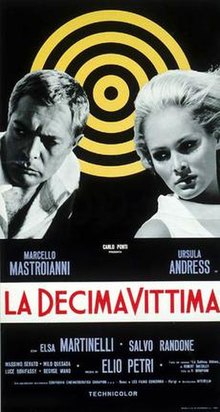
Marcello Vincenzo Domenico Mastroianni was an Italian film actor, regarded as one of his country's most iconic male performers of the 20th century. He played leading roles for many of Italy's top directors in a career spanning 147 films between 1939 and 1996, and garnered many international honours including two BAFTA Awards, two Best Actor awards at the Venice and Cannes film festivals, two Golden Globes, and three Academy Award nominations.

Divorce Italian Style is a 1961 Italian black comedy film directed by Pietro Germi. The screenplay is by Germi, Ennio De Concini, Alfredo Giannetti, and Agenore Incrocci, based on Giovanni Arpino's novel Un delitto d'onore. It stars Marcello Mastroianni, Daniela Rocca, Stefania Sandrelli, Lando Buzzanca, and Leopoldo Trieste.

A Special Day is a 1977 period drama film directed and co-written by Ettore Scola, produced by Carlo Ponti, and starring Sophia Loren and Marcello Mastroianni. Set in Rome in 1938, its narrative follows a housewife (Loren) and her neighbor (Mastroianni) who stay home the day Adolf Hitler visits Benito Mussolini.
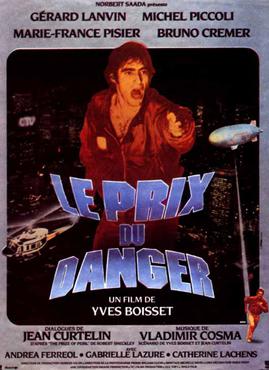
Le Prix du Danger is a 1983 French-Yugoslav science fiction movie, directed by Yves Boisset. It is based on Robert Sheckley's short story "The Prize of Peril", published in 1958.

Robert Sheckley was an American writer. First published in the science-fiction magazines of the 1950s, his many quick-witted stories and novels were famously unpredictable, absurdist, and broadly comical.
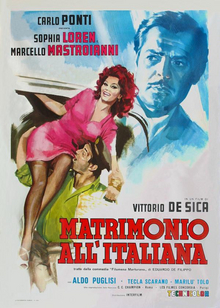
Marriage Italian Style is a 1964 romantic comedy-drama film directed by Vittorio De Sica, starring Sophia Loren and Marcello Mastroianni.
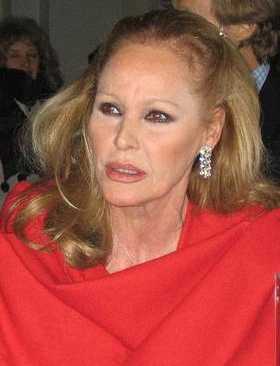
Ursula Andress is a Swiss actress, former model and sex symbol who has appeared in American, British and Italian films. Her breakthrough role was as Bond girl Honey Ryder in the first James Bond film, Dr. No (1962). She later starred as Vesper Lynd in the 1967 Bond parody Casino Royale. Other credits include Fun in Acapulco (1963), 4 for Texas (1963), She (1965), The 10th Victim (1965), The Blue Max (1966), The Southern Star (1969), Perfect Friday (1970), Red Sun (1971), The Sensuous Nurse (1975), Slave of the Cannibal God (1978), The Fifth Musketeer (1979), Clash of the Titans (1981), and Peter the Great (1986).

La dolce vita is a 1960 satirical comedy-drama film directed and co-written by Federico Fellini. The film stars Marcello Mastroianni as Marcello Rubini, a tabloid journalist who, over seven days and nights, journeys through the "sweet life" of Rome in a fruitless search for love and happiness. The screenplay, written by Fellini and three other screenwriters, can be divided into a prologue, seven major episodes interrupted by an intermezzo, and an epilogue, according to the most common interpretation.

The Stranger is a 1967 film by Italian film director Luchino Visconti, based on Albert Camus's 1942 novel The Stranger, with Marcello Mastroianni.

John Derek was an American actor, filmmaker and photographer. He appeared in such films as Knock on Any Door, All the King's Men, Rogues of Sherwood Forest (1950), and The Ten Commandments (1956). He discovered actress Bo Derek and she became his fourth wife.

Untouched by Human Hands is a collection of science fiction short stories by American writer Robert Sheckley. It was first published in 1954 simultaneously by Ballantine Books, both in hardback and paperback.

Eraclio Petri, commonly known as Elio Petri, was an Italian film and theatre director, screenwriter and film critic. The Museum of Modern Art described him as "one of the preeminent political and social satirists of 1960s and early 1970s Italian cinema". His film Investigation of a Citizen Above Suspicion won the 1971 Academy Award for Best Foreign-Language Film, and his subsequent film The Working Class Goes to Heaven received the Palme d'Or at the 1972 Cannes Film Festival.
"Seventh Victim" is a science fiction short story by American writer Robert Sheckley, originally published in Galaxy Science Fiction in 1953. In 1957 it was adapted for NBC's X Minus One radio play as "The Seventh Victim". It was heavily revised for the 1965 Italian movie The 10th Victim. Sheckley published a novelization of the film under that title the next year, and later followed with two sequels, 1987's Victim Prime and 1988's Hunter/Victim.

Yesterday, Today and Tomorrow is a 1963 comedy anthology film by Italian director Vittorio De Sica. It stars Sophia Loren and Marcello Mastroianni. The film consists of three short stories about couples in different parts of Italy. The film won the Academy Award for Best Foreign Language Film at the 37th Academy Awards.
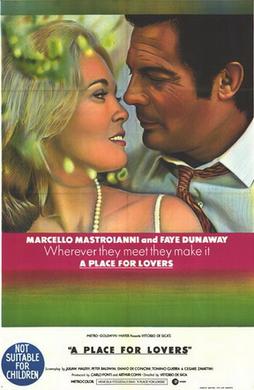
A Place for Lovers is a 1968 French-Italian romantic drama film directed by Vittorio De Sica and written by Brunello Rondi, Julian Zimet, Peter Baldwin, Ennio De Concini, Tonino Guerra and Cesare Zavattini. The film is based on the play Gli Amanti by Brunello Rondi and Renaldo Cabieri and was distributed by Metro-Goldwyn-Mayer.

Les Miserables is a 1948 Italian drama film directed by Riccardo Freda. It is based on the Victor Hugo's 1862 novel Les Misérables and stars Gino Cervi as Jean Valjean, Valentina Cortese as Fantine and Cosette, and Hans Hinrich as Javert. After the financial success of Freda's previous film The Black Eagle, Freda worked a deal with Lux Film and began developing an adaptation of Les Misérables with Mario Monicelli, Vittorio Nino Novarese and Stefano Vanzina. The film was shot entirely in Rome.

The Assassin is a 1961 Italian-French crime drama film directed by Elio Petri starring Marcello Mastroianni. It was Petri's feature film debut as a director.

Todo modo, also known in English as One Way or Another, is a 1976 Italian satirical political drama film directed by Elio Petri starring Gian Maria Volonté and Marcello Mastroianni. It is loosely based on the novel of the same name by Leonardo Sciascia.
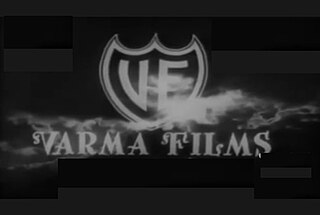
Varma Films was a film production and distribution company founded in Bombay, India. The company was predominantly involved in producing and distributing Hindi-language films and to a lesser extent distributing some Italian-language films with English subtitles in India.
